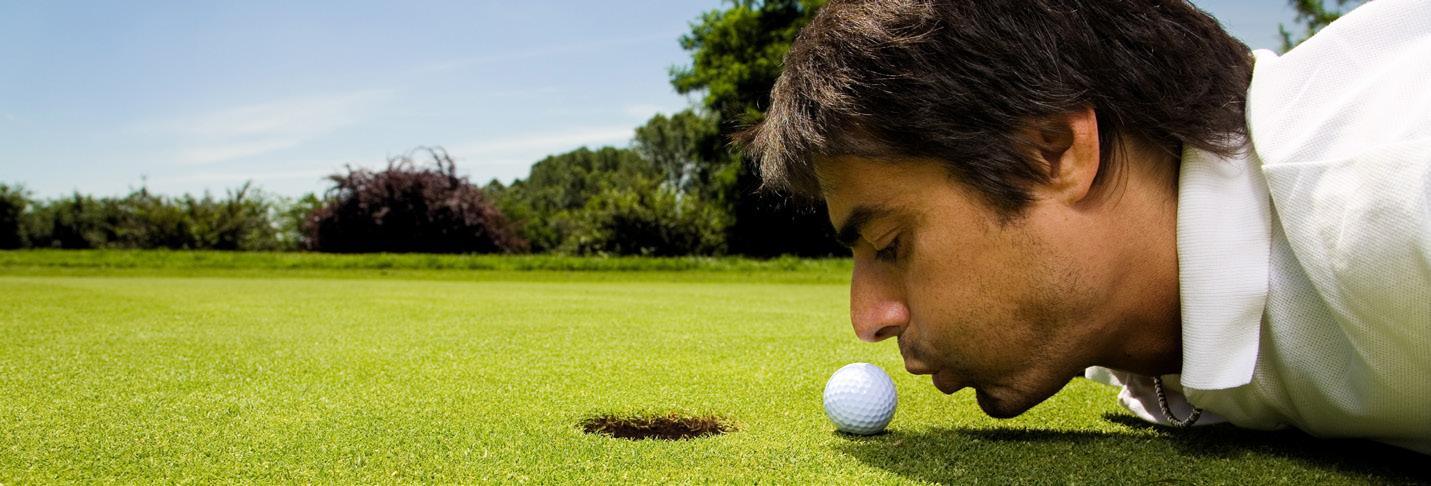
4 minute read
CONQUERING THE GREENS
Envision this scenario: you have just launched a beautiful driver shot off the tee and followed it up with an even better approach shot from the fairway. As a result, the ball is sitting 10 feet from the cup with a chance at birdie! You are probably feeling pretty good until you walk up to grab your putter and think to yourself “what on Earth do I do now?” You would be like many golfers who haven’t quite yet developed the skill of reading a putt.
In essence, you are attempting to envision the path your ball is going to take to hear that wonderful sound of the bottom of the cup. There are numerous factors that play into this potential success and we will review them here.
Advertisement
First things first. Determine an estimate of the distance your putt will need to travel. If the ball is a mile away from the hole and on the green, you need to adjust your strategy. You cannot realistically go for the hole and expect to make it from 40 feet and out. Instead, deploy the “lag” shot as it is called. This is a shot in which you do your best to get it relatively close to the hole in order to give yourself a true chance of sinking the next putt. On your way to grabbing the flagstick out of the hole, attempt to eyeball the distance by pacing off the walk carefully. There is a rule of thumb that for every foot of distance the club needs to be taken back 1 inch on the backswing (use that simply as a guide). Next, determine the bend or slope of the green. Not every putt is going to travel on a straight path towards the hole and you must realize that and account for it. Putts with a lot of break should fall into the cup from the side of the hole, not the front like most straight traditional putts. This allows you to really play the break and give you a better chance to hole out the putt. If you can’t determine the slope of a green, know that if there is water involved that the green USUALLY falls towards that hazard. The slope and break of a putt are the two biggest components of any putt. For example, if a putt has a lot of break but is downhill, you will need to compensate for the break more. The reason for this is that a slower putt will experience the full force of the break as opposed to a faster hit uphill putt. One last thing to keep in
mind is how to address putting out of the fringe. The fringe often outlines the greens and contains a thicker cut. Therefore the ball will slow down when traveling through it, so please take that into account and add speed to your putt. These are just a few simple keys to abide by around the greens and following them will work wonders on your game.
Do not be deceived by how much I have stressed the importance of hitting the “long ball” and approach shots. While it is absolutely imperative you have this part of your game down to get on the greens, what you do when you’re on the dance floor is just as important. You can hit the prettiest drive and stick your approach shot close and be looking at a birdie opportunity! But then if you three or even worse four putt, no one will remember your first two great shots. Today we are going to learn the bare bones basics of a solid, working putting stroke. Everyone please take heed; even you “big hitters” out there.
THE STANCE/SETUP
Often overlooked, this is the point at which the success (or lack thereof) is determined. If you want to put more putts in the bottom of the cup then you need to be careful how you set up.
• Aim to have your eyes over the ball and place the ball up in your stance; off your left foot • Grip hands with palms opposite of each other (one palm facing the other) • Grip should be about 6 on a scale of 10; relaxed and loose grip is always better
THE STROKE
Ensure shoulders are aligned parallel to the target line and form a triangle with your arms and hands.
• Maintain triangle throughout stroke and limit use of lower body • Pretend your arms form a pendulum; backswing should be the same tempo as downswing • Do NOT hesitate at any point. Trust your stroke and good things will happen
Unfortunately you cannot just walk up and hit the ball hoping for the best like you can in miniature golf. Greens actually have varying slopes, ridges, and other obstacles that mean you have to account for the speed and break of each putt. Before you make your putt, squat down and do your best to read the slope and speed and then pick a “line” to the hole. From there, align your ball along that target you pictured in your head and just trust it. Thinking too much is a silent killer for many putters on the green so don’t fall into a bad habit now. Happy putting!










